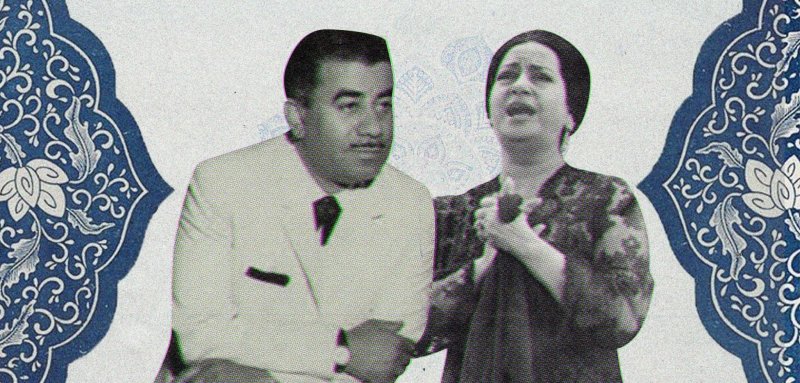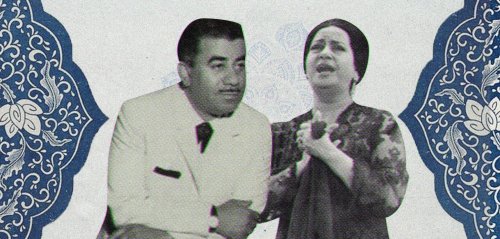By the end of the 1960s, Iranian cinema had reached self-sufficiency, with all stages of film production taking place inside the country. Cinema had entered Iran earlier, and watching films in theatres was already a popular and widespread form of entertainment.
Films of American, European and Arab (Egyptian, really) origins were being broadcast in Iran at the time, attracting a great deal of attention. During the 60s, a difficult period for local film production in Iran, Egyptian cinema became very popular in the country alongside Hollywood films, with this popularity continuing until the end of the 70s. It may be possible to refer to movie advertisements in cinemas published in the "Ettela'at" newspaper at the time. For instance, on the movie advertisements page in Issue 9122 published on September 20th 1956, of the 12 suggested films, seven were Hollywood pictures, two were Iranian, another two Egyptian, and the remaining three were European.
During this period, Iranians embraced the works of several Egyptian movie stars and music artists, rather, mainly stars who had mastered both art forms together. In turn, inspired by the Arabic music widely present in Egyptian films, a number of artists in Iran began singing songs in Persian. This type of music came to be known as the "folk" stage, and it became one of the most desired and requested artistic styles in Iran.
It is true that Egyptian cinema was of great popularity in Iran, but what this music and its artists brought to the arena of folk music was far greater than what had taken place in Iranian cinema. ‘Ghasem Jebeli’ may not have been the first to sing in Iran, but he was one of the first to try producing works of music similar to that of the Egyptian music known and played in the country, in line with the works of Farid Al-Atrash and Umm Kulthum.
Jebeli, followed by "Bahram Siyar" and "Davood Maghami" later on, approached this type of music all became prominent faces in the country’s general culture. From the 50s to the end of the 70s – that is when the Islamic revolution took place – they successfully formed one of the most important artistic tides in Iran, so much so that those with authority in the music industry could not keep their work from the public’s ears.
In fact, they were the subject of harsh criticism by Iran’s music professors as well as the political authority which was unwilling to promote this music. One of the reasons that made this music trend the subject of criticism was the low quality of the works produced, especially in comparison with their original sources - the music and the names that influenced them were created by prominent artists and composers in Egypt. The artists who reproduced this music trend may have been popular, but most of them did not have a notable position in Iran’s official music and academic arena. This music style was even dubbed - with some degree of contempt - as “market (Bazaar) and alley music” (or ‘Kovah Pazari’ in Persian).
A while back, Egyptian culture officials sent a letter to the Iranian government stating that ‘if you want to sing our songs, we will send you the notes ourselves.
In the first volume of his famous book "The History of Persian Music", Rūhollāh Khāleghi , one of the pioneers of musical research in the contemporary history of Iran, touches on this issue and writes, "Some time ago one of Egypt’s musicians came to the ‘Conservatory for National Music’ and played the oud. Then, the conversation shifted to music, and he asked in surprise: ‘Why do the singers on Radio Tehran play Arabic music so poorly and incorrectly? If they want to play our songs, is it not better for them to ask us for the songs’ notes so that they could play them correctly?’ I was too embarrassed to respond…”
This happened during the years of 1949 and 1959, during which Khāleghi was the director of the ‘Conservatory for National Music’. He refers to this memory in the midst of discussing the arrival of the zither musical instrument to Iran in his book. This incident is also narrated by one of the most prominent Iranian musicians, Abul Hasan Sabā (1902-1957), with some variation. In fact, one of Sabā’s students tells of one time when a young man’s voice singing a song by Ghasem Jebeli could be heard from the classroom. Sabā became furious when he heard it and began to insult the young man, exclaiming, "They aren’t ashamed of singing like this!". He added, "A while back, Egyptian music officials sent a letter to the Iranian government stating that ‘if you want to sing our songs, we will send you their notes ourselves. Play the notes correctly!’... We should be ashamed for disregarding these gentlemen...". This was mentioned in the book "In the Cage" written by Farhoud Safarzadeh about the life of the musician Sabā.
Despite anger expressed by Iran’s music professors towards this music trend, it remained popular. Since most of its singers and musicians belonged to the poor class in society, they were not supported by the government, which had a prominent role in the art field. They had rather formed their own market and proceeded in accordance with the supply and demand of the people without any governmental interference. It can be considered the most independent musical style in Iran's contemporary history that succeeded in drawing the public interest.
Following the revolution, the relationship between the artists of this trend and performing was severed, even though their popularity did not decrease. On the contrary, it continues to be the music of drinking and nightlife, that is, the music of "Abbas Qadri", "Jawad Yassari", "Sawsan" and their counterparts. Most of these works date back fifty years and are still available but in poor quality.
The voices of these singers could be heard from the cabarets of "Lalehzar", one of the oldest and most significant streets of Tehran that had a major influence on Iranian culture. This street was their meeting place, and this type of music was dubbed "the music of Lalehzar" until the right before the advent of the Islamic revolution. Even the Persian "pop" singers of the 1970s – who now reside in Los Angeles – call it the same name.
Right until the 1953 coup against Mosaddegh’s rule in Iran, the "Lalehzar" street was a space for protest theater and a meeting place for intellectuals. After the coup, however, it lost its splendor to later become a centre for those who used to be called “vocalists” – as the connotation of this word differs in Iran from its counterpart in other languages, thus the word “vocalist” in the modern Persian dictionary means the one who sings folk songs in entertainment venues and cabarets. In consequence, these singers took possession of the "Lalehzar" street that, in turn, lost its former elite visitors.
Arabic style music was subject to harsh criticism by Iran’s music professors as well as the political authority which was unwilling to promote this music
The singers and poets of this type of music were oddly fixated on places and civic grievances. In other words, city spaces that served as centers of gathering for people belonging to the poor class and lower stratums of society became a major theme in many of their songs. The folk dialect of the "men of integrity or chivalry” well-known among these classes was prominent in their singing style.
Most of their musical instruments were the same ones as those previously seen and heard at Egyptian concerts, but the songs and the quality of the performances were of a different nature altogether. For example, they did not have the approach and commentary that Umm Kulthum would have regarding social and political issues, and not a single political song was published for them. Most of their lyrical content pertained to their own specific form of flirtation and romantic courtship. Abbas Ghaderi, for instance, has a song called “Rock” (or ‘Teke Sang’ in Persian) in which he sings: “Congratulations you piece of rock, you do not have a compassionate heart that yearns / I envy you because you neither have a voice nor color / Nor a loving heart to leave with someone / Who breaks it with sadness and blood flows from your eyes...". Another famous song by Davood Maghami entitled "Heaven and Hell" (or ‘Behesht Va Jahanam’ in Persian) says: "Burn my heart as much as you can / And send me any horse you have / But there is a day of reckoning / And God will expose you / One day before the Lord's court / And prove to you that your face is black..."
One of the prominent and talented faces of this trend is “Nematollah Ahgasi” who re-sang the song “Mayhana” by the Iraqi singer “Nazem al-Ghazali” in the 70s. He also sang a Persian adaptation of the famous Iraqi song “Abu Quthaila” under the title “Lab Karoun” (Karoun Beach), which is a great river in Ahvaz and a symbol for the evenings of music and nighttime revelry during that period. Therefore, Ahgasi became well-known for these two songs, especially “Lab Karoun”, which remains to this day among the top listened-to dance songs for Iranians.
This musical wave was of a predominantly masculine nature, with the exception of a number of female singers such as "Shahbar", "Sawsan" and "Afet". "Sawsan" was a skilled singer with a longstanding vital position in public culture. "Shahbar" had a much different personality than "Sawsan" had, and this difference can be seen in each of their songs. One of "Shahbar’s" most famous songs was titled "Kallah Bajeh", which is a popular folk dish in Iran made using a lamb’s head and limbs.
Even though this music trend contained but a few women, they were very popular and a large portion of cafegoers in Tehran during the fifties and sixties would always request to hear their singing.
With the passing of time and following the rise of several names of Persian "pop" stars - whose works were heavily influenced by Western music in terms of method and framework - in the seventies, these ‘folk’ artists were eventually marginalized. However, some of them, such as "Sawsan", "Ali Nazari", "Javad Yasari", and "Ahgasi”, were able to hold on to their previous popularity throughout the decade.
Following the revolution and the ban of this type of music for nearly twenty years, many singers of this generation who had stayed in Iran could not accomplish much. However, with the passage of time, their previous works returned to folk and public spaces again. Despite this, there hasn't been any new artists to emerge in this genre in Iran and restore the popularity that the old generation had enjoyed.
In conclusion, this artistic tide was not able to clear the heavy shadows of Arab (Egyptian) music that it had fallen under and paint a more authentic image of itself by adding elements from Persian music culture. As much as this type of music remained popular amongst the general population, the intelligentsia and the elite continued to be angered by it. However, it is pleasant to note that listening to the singers of this genre is still a popular pastime in the middle and high-class nightlife of Iran.
Raseef22 is a not for profit entity. Our focus is on quality journalism. Every contribution to the NasRaseef membership goes directly towards journalism production. We stand independent, not accepting corporate sponsorships, sponsored content or political funding.
Support our mission to keep Raseef22 available to all readers by clicking here!
Interested in writing with us? Check our pitch process here!






